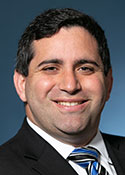The MMS Committee on Information Technology is proud to
announce the winners of our 18th annual Information Technology in
Medicine Awards. Each year, the committee extends cash awards to one
resident/fellow and one student through a competitive process that starts in
the fall. This year’s Resident winner Michael DiBenedetto for his project, Orthovision.
Dr. DiBenedetto is currently a resident physician in Orthopedic Surgery at the
University of Massachusetts Medical School. The student winner is Hillary
Mullan for her project, Using 3D Printing to Supplement Cadaveric
Dissection: Design and Manufacturing of a Model of the Female Perineum. Ms.
Mullan is currently a 3rd year medical student at the University of
Massachusetts.
 Dr. DiBenedetto is currently a resident physician in
Orthopedic Surgery at the University of Massachusetts Medical School. Dr.
DiBenedetto was raised in Oceanside, New York. He completed his
undergraduate degree in Biology/Molecular Genetics at Dartmouth College and
medical school at New York University. Dr. DiBenedetto is a self-taught
programmer. His first application, a Pebble Smartwatch application that
timed CPR chest compressions, was named an “App of the Week” by Pebble.
During medical school, Dr. DiBenedetto co-founded a company, Ximio Medical
Inc., to develop software which assists providers during a cardiac
arrest. Dr. DiBenedetto is one of the few developers working on
integrating augmented reality into the operating room. Other current
projects include iPhone apps which measure range of motion, help doctors
communicate in the hospital, and help surgeons communicate their post-operative
preferences with patients. Dr. DiBenedetto will be completing a
fellowship in hand surgery in 2020.
Dr. DiBenedetto is currently a resident physician in
Orthopedic Surgery at the University of Massachusetts Medical School. Dr.
DiBenedetto was raised in Oceanside, New York. He completed his
undergraduate degree in Biology/Molecular Genetics at Dartmouth College and
medical school at New York University. Dr. DiBenedetto is a self-taught
programmer. His first application, a Pebble Smartwatch application that
timed CPR chest compressions, was named an “App of the Week” by Pebble.
During medical school, Dr. DiBenedetto co-founded a company, Ximio Medical
Inc., to develop software which assists providers during a cardiac
arrest. Dr. DiBenedetto is one of the few developers working on
integrating augmented reality into the operating room. Other current
projects include iPhone apps which measure range of motion, help doctors
communicate in the hospital, and help surgeons communicate their post-operative
preferences with patients. Dr. DiBenedetto will be completing a
fellowship in hand surgery in 2020.
 Hillary Mullan is currently a third-year medical student at
the University of Massachusetts Medical School. As a medical student she has
spent time exploring the intersection of the humanities and medicine through
the creation and publication of various artworks and narrative essays. In 3D
printing, she has found an opportunity to marry her passion for medicine with
her interest in creativity and design. 3D-printing technology has made it
possible to efficiently and inexpensively produce anatomical models. As a data
file, her model of the female pelvis can be easily shared with institutions
worldwide. It is her hope that the incorporation of this model into learning
environments will promote a better understanding and appreciation of issues
relevant to women's health.
Hillary Mullan is currently a third-year medical student at
the University of Massachusetts Medical School. As a medical student she has
spent time exploring the intersection of the humanities and medicine through
the creation and publication of various artworks and narrative essays. In 3D
printing, she has found an opportunity to marry her passion for medicine with
her interest in creativity and design. 3D-printing technology has made it
possible to efficiently and inexpensively produce anatomical models. As a data
file, her model of the female pelvis can be easily shared with institutions
worldwide. It is her hope that the incorporation of this model into learning
environments will promote a better understanding and appreciation of issues
relevant to women's health.
